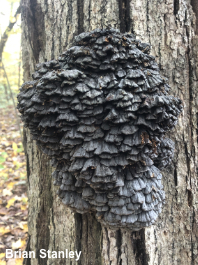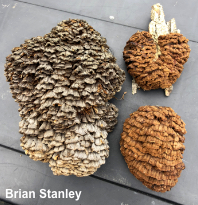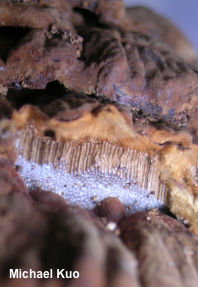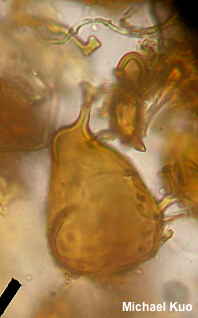| Major Groups > Polypores > Globifomes graveolens |

|
Globifomes graveolens [ Basidiomycota > Polyporales > Polyporaceae > Globifomes . . . ] by Michael Kuo Polypores are not often easily recognized (by me, anyway), but Globifomes graveolens is an exception. Found in North America east of the Rocky Mountains on the wood of oaks and other hardwoods, this funky mushroom develops a series of cascading, overlapping caps from a hidden central core of flesh. The odor of Globifomes graveolens is often reported as potentially strong and sweet—by authors who say that, in their own experience, there is no such odor. Overholts (1953) may have started this tradition; he reports no odor from any of the numerous collections he has studied, but says that "many years ago when a fresh collection was shown to my father he at once recognized it as 'sweet knot' and described how on occasions he had seen the fungus placed in living rooms, where it soon scented the whole house." You are welcome to do with that what you will. The specimens I have studied had no distinctive odor. Thanks to Brian Stanley for documenting, collecting, and preserving Globifomes graveolens for study; his collection is deposited in The Herbarium of Michael Kuo. Description: Ecology: Saprobic and possibly parasitic; appearing on deadwood and from the wounds of living hardwoods (primarily oaks); causing a white rot; annual, or perennial for a few years; summer and fall—or year-round in warmer climates; originally described from Georgia; widely distributed in North America east of the Rocky Mountains. The illustrated and described collection is from Ohio. Fruiting Body: 10–23 cm high; 8–16 cm across; 6–10 cm deep; a mass of tightly packed, overlapping individual caps arising from a central core. Individual caps: 1–5 cm across; semicircular to fan-shaped; planoconvex to flat; often drooping; bald or finely fuzzy; dry; with vague concentric zones of color; reddish brown to brown, becoming dull brownish gray with age. Pore Surface: Grayish, becoming brownish to brown; not bruising; pores round and small (2–4 per mm), with thick dissepiments; tubes 2–4 mm deep. Flesh: Granular in the central core; tough and fibrous in the caps; pale to dark brown; unchanging when sliced. Odor: Not distinctive. Chemical Reactions: KOH slowly black on flesh of dried specimens. Microscopic Features: Spores not found; reported (Gilbertson & Ryvarden 1987) as 10–14 x 3–4 µm; cylindric; smooth; hyaline in KOH; inamyloid. Basidia 4-sterigmate. Hymenial cystidia not found. Setae not found. Hyphal system trimitic: generative hyphae 3–5 µm wide, smooth, thin-walled, hyaline in KOH, with clamp connections; skeletal hyphae 4–6.5 µm wide, smooth, thick-walled, brown in KOH; binding hyphae 5–10 wide, very thick-walled, aseptate. Sclerids abundant in granular core context; thick-walled; reddish brown in KOH. REFERENCES: (Schweinitz, 1822) Murrill, 1904. (Murrill, 1908; Overholts, 1953; Gilbertson & Ryvarden, 1987; Lincoff, 1992; Binion et al., 2008; Elliott & Stephenson, 2018.) Herb. Kuo 10182001. This site contains no information about the edibility or toxicity of mushrooms. |
© MushroomExpert.Com |
|
Cite this page as: Kuo, M. (2020, October). Globifomes graveolens. Retrieved from the MushroomExpert.Com Web site: http://www.mushroomexpert.com/globifomes_graveolens.html |




